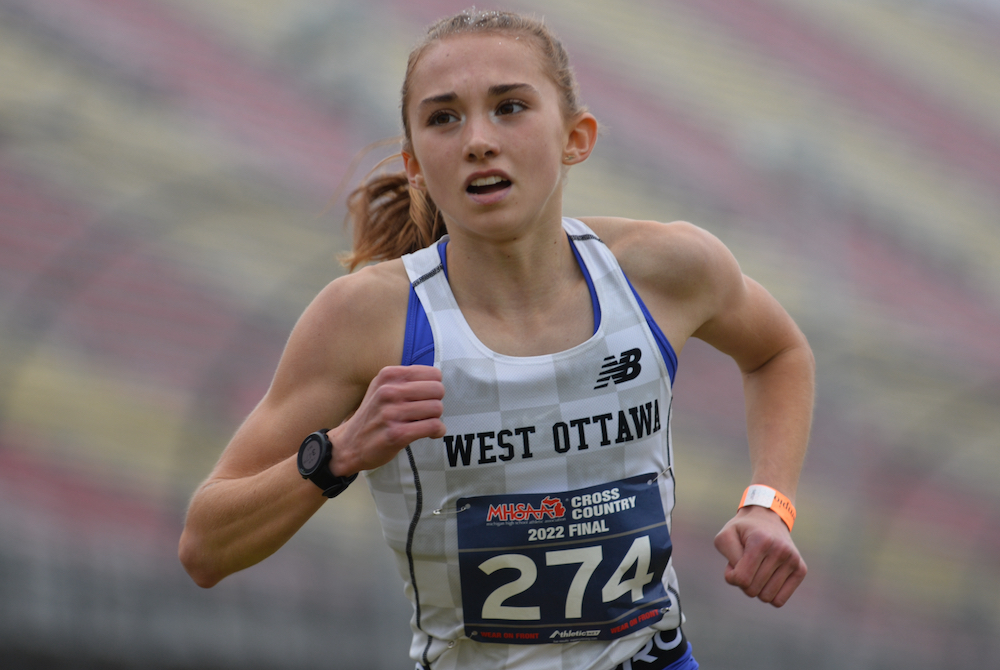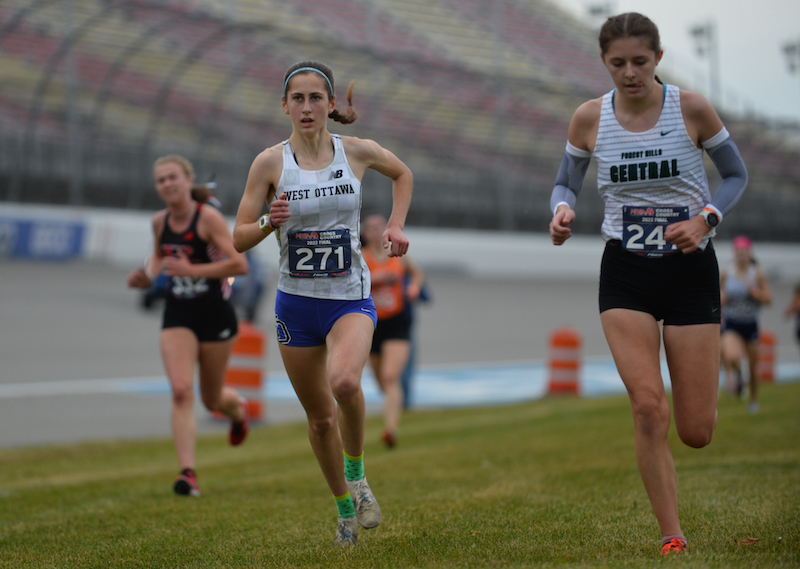
MHSAA Vault: MIS Rose to Challenges to Host 2020 LP Finals
By
Rob Kaminski
MHSAA benchmarks editor
November 12, 2021
The “MHSAA Vault” features stories from past publications and other documents in the MHSAA Library. This issue takes a look at the MHSAA Cross Country Finals at Michigan International Speedway, which celebrated 25 years in 2020 – although it was an event that nearly didn’t happen last fall …
In 1996, the MHSAA and Michigan International Speedway began a partnership the changed the course of the Lower Peninsula Cross Country Finals – quite literally.
The land in and around the track at Brooklyn would host the Finals for all classes of runners in one place on one day, an annual festival of nearly 2,000 runners competing for the MHSAA’s top honors.
Even skeptics – and there were several among running purists who thought the course was too flat, for example – can’t deny the results.
Finals attendance nearly doubled in that first year, and crowds in excess of 10,000 have enjoyed a day of racing several times, including a record 12,153 in 2011.
Enthusiastic crowds were the norm in recent years, with 11,232 in 2017, and nearly 11,000 in 2018 (10,989) and 2019 (10,873).
In fact, attendance failed to reach at least 8,000 only twice since the move to MIS.
Of course, last year was an exception, when attendance was limited to 1,000 spectators per session due to the COVID-19 Pandemic. Fans also were restricted to the grandstands rather than following the action throughout locations on the course.
To reduce the number of runners in each race, the event was spread over two days, with each Division being run in two separate “sections” with times then combined at the end to determine team and individual champions.
While not ideal, the end result was another year of fantastic efforts at MIS – both from student-athletes and those behind the scenes.
“Even at the last hour, less than a week ahead of the Finals, we were closer to not having the Finals than we were to having them,” said MHSAA Assistant Director Cody Inglis, who coordinates the cross country postseason. “Rumors and challenges of mandated shutdowns, testing and other requirements were being discussed and caused a lot of unknowns. Even at the Regional level, we had schools, Regional courses and hosts shutting down their facilities; we had to relocate four Regionals 48 hours prior to race times. That scenario just could not happen at the Finals level where far more runners and much more travel would be involved.”
Among the many last-minute hurdles was the edict from NASCAR – which owns MIS – that all persons on site be temperature checked upon entry. That meant securing thermometers that were easy to operate in short order, along with personnel necessary to conduct the readings.
The attendance limitations certainly helped to implement the temperature screening, but brought their own issues.
“Limiting spectators was not a popular decision, but it really was the only way to have a race,” Inglis said. “We were taking direction and working with policies and protocols from the MDHHS, the Governor’s office, Lenawee County Health Department, MIS and NASCAR.”
Part of the solution was to utilize the grandstands as a “barrier” between participants and spectators. The reduced number of fans were dispersed over thousands of seats while still allowing them the chance to watch their student-athletes compete.
“It wasn’t the same, it wasn’t easy or perfect, but it was what we had to do to have a race,” Inglis said. “Separating the Finals into two days and different sections also allowed us to spread out the event and limit the number of people on site at any one time. This was a key part of the plan and worked well even though it separated races within a Division.”
The MHSAA, MIS and the cross country community never lost focus of the main goal: a culmination of the season for the student-athletes, who deserved something last year more than ever. And, more than ever, MIS once again displayed its advantage as a venue that could adapt to the fluid nature of the times to pull off the event.
“There were some thoughts of using four different sites, but as we learned during the Regionals, the climate of things was so tenuous from one area of the state to another that we couldn’t be 100-percent certain that there wouldn’t again be last-minute cancelations,” Inglis said. “MIS was wonderful to work and collaborate with, and was the best option to get it done. It was never mentioned once publicly about the possibility of not having the Finals – only how we could best do it under uncharted conditions.”
The moving parts and ever-changing scenarios created more complexity than ever in finalizing a season, but every decision was made with the complete desire to conduct the Finals as close to normal as possible.
“I firmly believe that a finish to the season, no matter the differences in race formatting and fan experience, was something everyone would have taken when the season began in August,” Inglis said.
Indeed, the finish line in Year 25 at MIS might have been the most gratifying of them all.

Sachs Surges from Start to Lead Holland West Ottawa to LPD1 Finals Sweep
November 5, 2022
BROOKLYN – Helen Sachs of Holland West Ottawa doesn’t run alone in many cross country meets, which is unusual for an elite runner.
The best runners have to learn to race solo, because there will be meets in which they can simply overwhelm the competition.
But there is always at least one worthy competitor nearby when Sachs races. She runs on the same team as senior Arianne Olson, herself one of the top contenders at the MHSAA Lower Peninsula Division 1 Final on Saturday at Michigan International Speedway.
So, Sachs was surprised to find herself already alone at the front just 200 meters into the race. She never allowed the pack to catch up, winning by 24.73 seconds with a time of 17:18.74.
“I saw nobody in front of me except for the start when they all went off,” said Sachs, a sophomore. “I was just in front. I was like someone is gonna be coming up behind me, because I know the state meet is when people just go for it. No one came up with me.
“It was kind of weird. I was looking forward to some competition or people to run with. It was still fun to run in such a big race, though. It was cool.”
 Sachs won eight of her 10 races this season, placing second in the other two to Olson. Olson, who was third in Division 1 last season, placed ninth this time in 18:27.13.
Sachs won eight of her 10 races this season, placing second in the other two to Olson. Olson, who was third in Division 1 last season, placed ninth this time in 18:27.13.
That powerful 1-2 punch up front allowed West Ottawa to win the team championship in dominant fashion, 97-172 over runner-up Romeo.
The Panthers placed their five scoring runners in the top 50, while every other contending team had at least one scoring runner place in the 100s.
Training daily with such a powerful team helped Sachs become an MHSAA champion.
“I just picked up on the dedication, getting everything in,” she said. “Our coaches this year focused more on recovery, like running easy, focusing on recovery, which has helped the mindset of everyone on the team.”
Sachs was a ready-made contributor to the West Ottawa program, finishing fifth in Division 1 last season. But even after finishing among the state’s elite a year ago, she didn’t believe she could win an MHSAA individual championship until she started winning big races early this year.
“It’s surreal,” she said. “Last year I was fifth. This year, winning the state championship was crazy. It doesn’t feel real.”
Rounding out the West Ottawa scorers were 38th-place senior Megan Postma, 49th-place sophomore Jane Olney and 50th-place freshman Ava Porras. Grandville senior Allison Arnsman was the individual runner-up in 17:43.47.
PHOTOS (Top) Holland West Ottawa’s Helen Sachs closes in on the finish and her first MHSAA Finals championship. (Middle) West Ottawa’s Arianne Olson and Grand Rapids Forest Hills Central’s Clara James-Heer lead another pack down the stretch. (Click for more from Dave McCauley/RunMichigan.com.)

